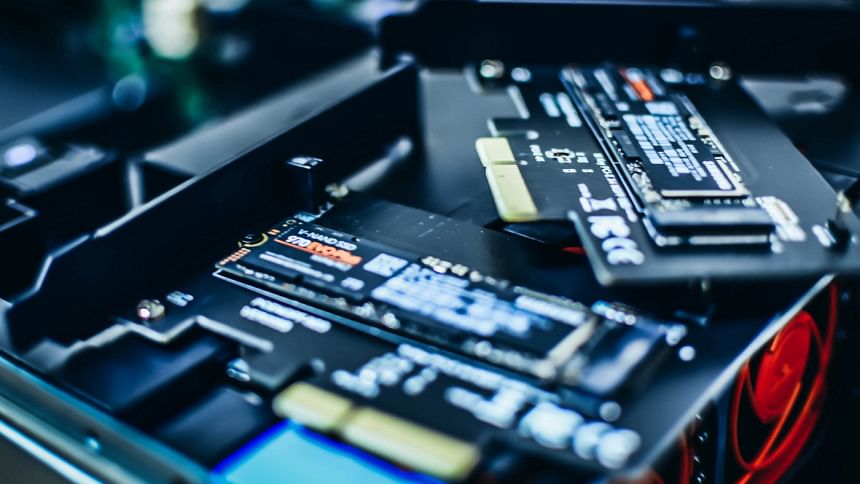Choosing the right NVMe SSD: a user-guide for PC builders

If you are building a PC, you probably have already picked your motherboard, CPU and RAM. But what about the NVMe SSDs? These are storage devices that use flash memory to store data. NVMe stands for Nonvolatile Memory Express, and SSD stands for Solid State Drive. NVMe SSDs are faster, quieter, more reliable, and more energy efficient than other storage options. However, picking the right NVMe SSDs for your PC can be tricky because you need to consider myriad factors. You might also get confused by their technical terms or even by marketing labels like creator or gaming. This guide will explain the basics of NVMe SSD and what a new buyer should look out for.
How do SSDs work?
To comprehend the magic behind NVMe SSDs, let's zoom in on their internal structure. NVMe SSDs are a type of storage device that consists of three types of chips: NAND flash, Cache and DRAM memory, and a controller. NAND flash is the main storage area, with cells that can hold one or more bits. Cache memory is a temporary buffer that speeds up data transfer. The controller manages data flow and wear levelling of the cells. Each chip has a different capacity and can be located on either side of the SSD. Inside the chips, SSD cells are like small containers that can be filled and emptied with data. SSDs have limited write cycles, and this is why SSDs use wear levelling algorithms to distribute the writes evenly across the cells and extend their lifespan. The number of write cycles that a cell can handle is called endurance, and it varies depending on the type and quality of the NAND flash.
Gaming vs Creator SSDs Myth
Many NVMe SSDs are marketed as gaming, professional, or industrial. These designations are primarily marketing strategies. There is no real difference between a gaming, an industrial, or a creator SSD. The word gaming here does not imply any special feature or limitation; the same goes for the other categories. The actual performance of an NVMe SSD depends on other factors, such as the speed, the interface, the capacity, and the endurance of the drive. These factors may vary depending on the type and quality of the NAND flash, the controller, and the SSD firmware. Some SSDs may be better suited for certain applications than others. However, your NVMe SSD choice can be optimised based on your specific use cases. Therefore, you should not be misled by the industry jargon and look at the actual specifications and benchmarks of the drives.
Why HIGH reading and writing speeds can be misleading
The read and write speed of an SSD is a key feature that shows how quickly it can access and transfer data. PCIe Gen 4.0 SSDs can achieve up to 7 GB/s, which sounds amazing. However, these numbers are not very meaningful in ground reality. Most of us won't benefit from these speeds because the software and the files we use can't take advantage of them. This applies to 99 per cent of the people in the world. Most files are too small to need such high speeds, and most software, such as Windows and other programs, are not optimised to handle PCIe 4.0 or 5.0 bandwidth. In fact, they can't even use the full PCIe 3.0 bandwidth, which is around 3.5 GB/s. Only a handful who work with large files, such as 4K video, might notice some differences from higher speeds. So don't be intimidated by the PCIe generations and the read and write speeds.
TBW - Tera Bytes Written
If you want to know how durable an NVMe SSD is, you should look at the terabytes written (TBW) spec. TBW stands for Terabytes Written. This tells you how much data you can write and erase on the SSD before it wears out. The higher the TBW, the more durable the SSD is. For example, a Seagate Firecuda PCIe Gen4 SSD with one TB of storage has a TBW rating of 1275, while a 1TB Samsung 990 Pro only has 600, which is half as much. Put another way, you can write and delete about 70% of the drive capacity every day over its five-year lifetime. That's a lot of data! Speed only tells you how fast the SSD can transfer data, not how long it can last. So, the TBW spec shows you how reliable and long-lasting an SSD is.
Cache and DRAM memory
Cache and DRAM memory are important for SSD performance. Cache memory is a fast memory that stores frequently used data. NVMe SSDs use different types of cache, such as SLC, MLC, TLC NAND flash, or DRAM, with varying speeds, capacities, and endurance levels. However, the cache size and type may vary depending on the SSD model and manufacturer. DRAM memory, on the other hand, is volatile and stores the mapping information of NAND flash memory, which is needed to find and access data on the drive. NVMe SSDs with DRAM memory can have faster and more stable performance than DRAM-less NVMe SSDs, which store the mapping tables on the NAND flash memory or use the host system's memory (HMB) for caching. Compared to a 500GB NVMe SSD, a one TB NVMe SSD usually has more cache and DRAM, which boost its performance, durability and data mapping efficiency. Both cache and DRAM memory affect SSD speed and efficiency, especially in larger-capacity models.
Controller
A controller in an NVMe SSD is a chip that executes the NVMe protocol and communicates with the storage media and the system CPU using PCIe sockets. It is one of the most important factors to consider because it affects the performance, efficiency, and compatibility of the SSD. A good controller can support higher data transfer rates, lower latencies, and more input/output operations per second than otherwise. Therefore, when choosing an NVMe SSD, you should look at what kind of controller that SSD uses.
Firmware
Firmware is a software program stored in a device's memory, usually a NAND chip. It contains essential code and commands that enable a device to function. Firmware in an NVMe SSD influences the drive's performance, reliability, and quality. Therefore, you should check the firmware version and update availability when buying an NVMe SSD. Some manufacturers, such as Seagate, offer firmware updates and instructions on their websites, while others need special tools or software to update the firmware.
SSD recommendation for your tasks and workflows
Different SSDs have different performance levels depending on how you use them. To choose the best SSD for your needs, you must understand how to categorise drives based on their performance in specific tasks and workflows. Here are some common types of drives and recommended NVMe SSDs:
OS and Programs Drive: This is the drive where you install your operating system and your programs. It needs to always access many different parts of the SSD, with random reads and writes. This drive should be super-fast and responsive, as it determines the overall performance of your system. For this drive, I suggest the Seagate FireCuda 530 series PCIe Gen4 NVMe 1.4 drive for its blazing speed and impressive terabyte written rating.
Project Drive: If you work with large files, you need a drive that can store them and transfer them quickly and reliably. This means the drive should support sequential reads and writes with high bandwidth and endurance, as it will face a lot of data movement and stress. The Seagate FireCuda 530, the Lexar NM800Pro, and the ADATA Legend 960 PCIe Gen4 NVMe SSD are three drives that meet these criteria.
Data Storage Drive: This drive is for storing large files that you rarely use but might need to access sometimes. It should have a lot of storage space and low wear. This way, it can act as a backup and archive for your files. The Lexar PCIe NM790 and the ADATA Legend PCIe Gen4 900 series are good choices for this drive. They have balanced performance and endurance.
Final Thoughts
Selecting the right SSD goes beyond raw read and write speeds. By evaluating your specific needs and workflows, you can make an informed decision that aligns with your budget and provides optimal performance for your unique use cases. Before making a purchase, consider your storage needs carefully. I strongly advise avoiding SSDs below 500GB—an SSD with 500GB or more offers a versatile and future-proof solution. Larger SSDs generally have lower prices per GB due to economies of scale and lower manufacturing costs, but performance gains may not be universally applicable. To avoid buying counterfeit Seagate, Lexar and Adata NVMe SSDs and missing proper warranty coverage of 3-5 years, buy only the product with the official distributor Global Brand Pvt Ltd sticker on it.

 For all latest news, follow The Daily Star's Google News channel.
For all latest news, follow The Daily Star's Google News channel. 




Comments